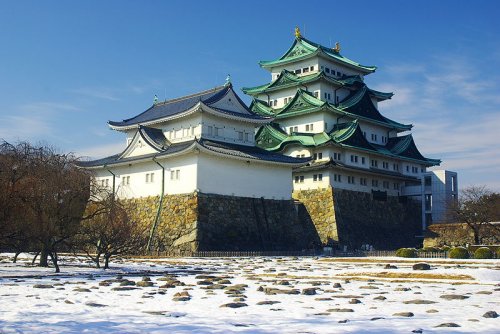Nagoya (Japanese: 名古屋市) is the third biggest incorporated city within the fourth most populous urban area in Japan. There are 2.2 million people living in Nagoya, within the Chukyo Metropolitan Area, which has over 8.7 million inhabitants. Nagoya is also the capital of Aichi Prefecture. It was the base for the powerful Japanese warlord Oda Nobunaga and his successors, the famous shoguns Toyotomi Hideyoshi and Tokugawa Ieyasu.
Tokugawa Ieyasu put Nagoya on the map when he moved his base there in 1610, constructing Nagoya Castle using materials taken from Kiyosu Castle. The townspeople of Kiyosu were systematically relocated to Nagoya, over 60,000 of them, and with their arrival, temples and shrines were rapidly put up. The ancient Atsuta Shrine was designated a way station of the Tokaido route, the road linking Kyoto to present-day Tokyo. Nagoya Castle and Atsuta Shrine are two of the famous tourist attractions in Nagoya today.
By the beginning of the 20th century, Nagoya became a manufacturing hub of Japan. It is the base for many multinationals such as Toyota (headquartered in nearby Toyota, to the east of Nagoya) and Mitsubishi Motors.
The warmest months in Nagoya are July and August, when the average high temperate may exceed 30.5°C (87°F). Coldest months are January and February, with average low temperature reaching 1°C (34°F). June and July are the wettest months, with precipitation of over 201.5 mm (7.93 inches), while the driest are December and January, with precipitation of 43.2 mm (1.7 inches) or less.
 Nagoya, Japan
Nagoya, JapanSource: http://commons.wikimedia.org/wiki/File:Nagoya_dome_from_Midland_Square.JPG
Author: Chris 73

Author: Chris 73

 Nagoya Castle
Nagoya CastleSource: http://commons.wikimedia.org/wiki/File:Nagoya_csl_snow_piled_up.jpg
Author: NNE

Author: NNE

Planning your trip to Nagoya
By PlaneNagoya is served by the Chubu Centrair International Airport (NGO), a new airport which opened in 2005. The Meitetsu Airport Line connects the airport to downtown Nagoya. The trains are called the μSky (pronounced meu-sukai), which makes the journey in 28 minutes at a cost of ¥1200. Note that the ride is not free for JR Railpass holders.
By Train
You can also reach Nagoya by train. The Shinkansen going between Tokyo and Osaka stops there. A ride from Tokyo takes an hour 40 minutes on the Nozomi bullet train, and costs ¥10,780, while the Hikari bullet train takes between 1 hour 45 minutes to two hours, and costs ¥10,580.
On the opposite direction, Nagoya is 53 minutes from the Shin-Osaka Station in Osaka on the Nazomi (fare ¥6,380) and between 53 to 70 minutes on the Hikari or Kodama (fare ¥6,180).
Planning your travel within Nagoya
To be honest, it is more practical to explore Nagoya by car than by public transport. It does have a subway system with tour lines. The red Sakuradori Lne heads southwest, the purple Meijo Line loops aroound the eastern side of Nagoya, the yello Higashiyama Line links Nagoya with Fushimi, Sakae and Fujigaoka, and the blue Tsurumai Line links it with Fushimi and Osu Kannon, heading south.If you plan to use the subway extensively, get the one-day pass for unlimited rides for ¥600.
 The 36-storey 170-meter Mode Gakuen Spiral Towers in Nagoya
The 36-storey 170-meter Mode Gakuen Spiral Towers in NagoyaSource: http://en.wikipedia.org/wiki/Mode_Gakuen_Spiral_Towers
Author: Kansai explorer

Author: Kansai explorer

Places of Interest in Nagoya
- Nagoya Castle
The famous landmark of Nagoya built by Oda Nobunaga, the famous Japanese warload. - Atsuta Shrine
The second most sacred Shinto shrine in Japan after the Ise Shrine. - Tokugawa Art Museum
Museum housing superb Edo-era treasures. - Koshoji Temple
17th century temple established by the Tokugawa Family that holds the annual 1000 Lantern Festival. - Toganji Temple
Temple with a seated Buddha, with ties to Hinduism, honoring among others the Hindu goddess Saraswati. - Arako Kannon Temple
The oldest building in Nagoya, with the original constructed in the 8th century. - Osu Kannon Temple
Originally founded in Kamakura, it was moved here by Tokugawa Ieyasu in 1612. The present main building dates to 1970. - Shiroyama Hakusan Shrine
Shrine that holds festivals featuring Japanese dance and music. - Nittaiji Temple
Temple with the 15-meter Gandala-style Taian Pagoda, and also housing relics presented by the King of Thailand. - Toyota Automobile Museum
Museum with a large collection of cars from many countries and manufacturers. - Toyota Commemorative Museum of Industry and Technology
Museum located on the site of the original Toyota loom factories, that tells the story of the Toyota Corporation, from loom manufacturer to the world's largest car maker. - Nagoya Boston Museum of Fine Arts
Museum showcasing some of the artworks of the Boston Museum of Fine Arts. - Nagoya Tower
The oldest TV tower in Japan standing at a height of 100 meters. - Hisaya-Odori Park
Public park with view of Nagoya Tower. - Aichi Prefectural Museum of Art
Museum with work by 20th century Japanese artists as well as others.
 Latest updates on Penang Travel Tips
Latest updates on Penang Travel Tips
 Map of Roads in Penang
Map of Roads in Penang
Looking for information on Penang? Use this Map of Roads in Penang to zoom in on information about Penang, brought to you road by road.
Copyright © 2003-2025 Timothy Tye. All Rights Reserved.

 Go Back
Go Back